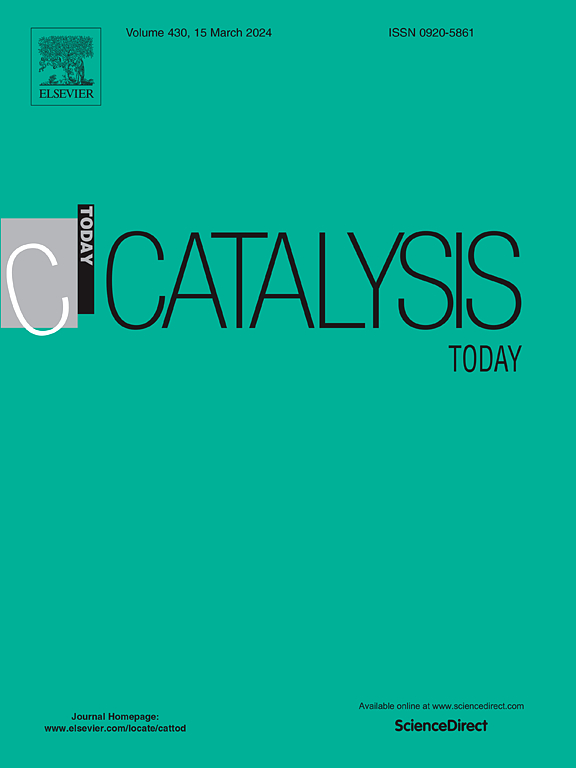探测催化反应中的电子转移:催化黄金法则和非无害载体的作用
IF 5.2
2区 化学
Q1 CHEMISTRY, APPLIED
引用次数: 0
摘要
以电子转移为速率决定步骤的催化反应,其活化能随组分或载体变化不大。本研究提出了一种实验方法来证实电子转移参与了rds。这里提出的概念适用于多相催化。电催化作用。还有电池系统。臭氧分解是催化反应的一个例子,其中电子转移是限速的。利用原位x射线吸收近边结构(XANES)探测电子转移和扩展x射线吸收精细结构表征催化剂结构。催化剂分别为3.0 wt%和10 wt%的氧化锰负载在SiO2和Al2O3上。氧化铝负载的催化剂比二氧化硅负载的催化剂对臭氧具有更高的分解活性和更高的转换频率。两种催化剂的动力学研究表明,速率决定步骤是吸附在锰中心的过氧化物的分解,这一步骤涉及电子转移。在反应条件下的XANES测试表明,氧化铝负载的催化剂具有更大的后边缘面积,即更高的未占据态密度ρ(E),这与更高的电子接受能力有关。过氧化物分解的速率常数取决于ρ(E),因此具有与费米控制原子内电子跃迁的黄金法则相同的形式。因此,催化电子转移被描述为遵循催化黄金法则。这种用法适用于载荷随单个支架变化或涉及不同支架的系统,在这种情况下,如果支架影响ρ(λ),则将其指定为非无害支架。原位XANES方法提供了一种探测不同于传统配体效应的电子效应的方法。本文章由计算机程序翻译,如有差异,请以英文原文为准。
Probing electron transfer in catalytic reactions: A Catalysis Golden Rule and the role of non-innocent supports
Catalytic reactions in which the rate-determining step (rds) is electron transfer often display activation energies that vary little with composition or supports. The present study presents an experimental means to confirm that electron transfer is involved in the rds. The concepts presented here have applicability in heterogeneous catalysis. electrocatalysis. and battery systems. Ozone decomposition serves an example of a catalytic reaction in which electron transfer is rate-limiting. Use is made of in situ X-ray absorption near-edge structure (XANES) to probe the electron transfer and extended X-ray absorption fine structure to characterize catalyst structure. The catalysts were 3.0 and 10 wt% manganese oxide supported on SiO2 and Al2O3. The alumina-supported catalysts were more active for the decomposition of ozone with higher turnover frequencies (TOFs) than the silica-supported catalysts. In both catalysts kinetic studies indicated that the rate-determining step was the decomposition of an adsorbed peroxo species on a Mn center, a step that involves electron transfer. XANES measurements at reaction conditions showed that alumina-supported catalysts had larger post-edge areas, namely higher unoccupied density of states ρ(E), which is associated with higher electron-accepting capability. The rate constant for the peroxide decomposition depends on ρ(E), so has the same form as Fermi's Golden Rule governing intra-atomic electron transitions. As such, the catalytic electron transfer is described as following a Catalysis Golden Rule. The usage is applicable to systems where loading is varied with a single support or where different supports are involved, in which case the supports are designated as non-innocent supports if they affect . The in situ XANES method provides a means of probing an electronic effect that differs from the conventional ligand effect.
求助全文
通过发布文献求助,成功后即可免费获取论文全文。
去求助
来源期刊

Catalysis Today
化学-工程:化工
CiteScore
11.50
自引率
3.80%
发文量
573
审稿时长
2.9 months
期刊介绍:
Catalysis Today focuses on the rapid publication of original invited papers devoted to currently important topics in catalysis and related subjects. The journal only publishes special issues (Proposing a Catalysis Today Special Issue), each of which is supervised by Guest Editors who recruit individual papers and oversee the peer review process. Catalysis Today offers researchers in the field of catalysis in-depth overviews of topical issues.
Both fundamental and applied aspects of catalysis are covered. Subjects such as catalysis of immobilized organometallic and biocatalytic systems are welcome. Subjects related to catalysis such as experimental techniques, adsorption, process technology, synthesis, in situ characterization, computational, theoretical modeling, imaging and others are included if there is a clear relationship to catalysis.
 求助内容:
求助内容: 应助结果提醒方式:
应助结果提醒方式:


